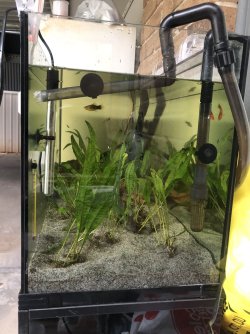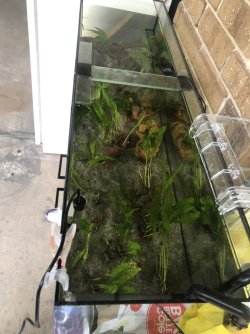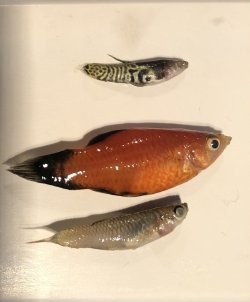hi, I have a 50 gallon tank, which has been fishless cycled for the past month. I introduced 2ppm ammonia until the water parameters were able to absorb ammonia and nitrite in 24hrs. Then I adjusted to 3ppm (for assurance) and that was successful too. I then added 16 fish to my aquarium on the 30th June (6 endlers and 10 Platys). So far I’m left with 10 fish remaining and it’s been less than a week.
Tested the water parameters today:
Ph - 7.6
Water temp - 78 degrees Fahrenheit (26 Celsius)
Ammonia - 0.0ppm
Nitrite - 0.0 ppm
Nitrate - 10ppm
I’m unsure what the hardness is.
I did a 50% water change the morning of the 30th June and got nitrate to below 10ppm. I introduced the fish in the afternoon. I did a drip acclimation for 45 minutes. I use seachem prime to condition the water. This aquarium is at my parents house and I go over every second day to monitor water parameters and conduct any maintenance. My mother feeds the fish twice a day (morning and night).
I live in the southern parts of Australia and currently it’s winter. The aquarium is set outside under the patio. Currently temperature reach 48 degrees Fahrenheit at night and 60 degrees Fahrenheit during the day. I use a fluval 300w heater to heat the tank.
Can anyone please give me advice on what I might be doing wrong? Below is a picture of a platy I found today. I Cannot see any signs of wear on the fish but then again I’m a novice and probably missing something.
Also this aquarium does not have a lid, was given to my parents from a friend. I use a sand substrate that was also provided. I rinsed the substrate, sand and canister filter thoroughly before use.

Tested the water parameters today:
Ph - 7.6
Water temp - 78 degrees Fahrenheit (26 Celsius)
Ammonia - 0.0ppm
Nitrite - 0.0 ppm
Nitrate - 10ppm
I’m unsure what the hardness is.
I did a 50% water change the morning of the 30th June and got nitrate to below 10ppm. I introduced the fish in the afternoon. I did a drip acclimation for 45 minutes. I use seachem prime to condition the water. This aquarium is at my parents house and I go over every second day to monitor water parameters and conduct any maintenance. My mother feeds the fish twice a day (morning and night).
I live in the southern parts of Australia and currently it’s winter. The aquarium is set outside under the patio. Currently temperature reach 48 degrees Fahrenheit at night and 60 degrees Fahrenheit during the day. I use a fluval 300w heater to heat the tank.
Can anyone please give me advice on what I might be doing wrong? Below is a picture of a platy I found today. I Cannot see any signs of wear on the fish but then again I’m a novice and probably missing something.
Also this aquarium does not have a lid, was given to my parents from a friend. I use a sand substrate that was also provided. I rinsed the substrate, sand and canister filter thoroughly before use.





